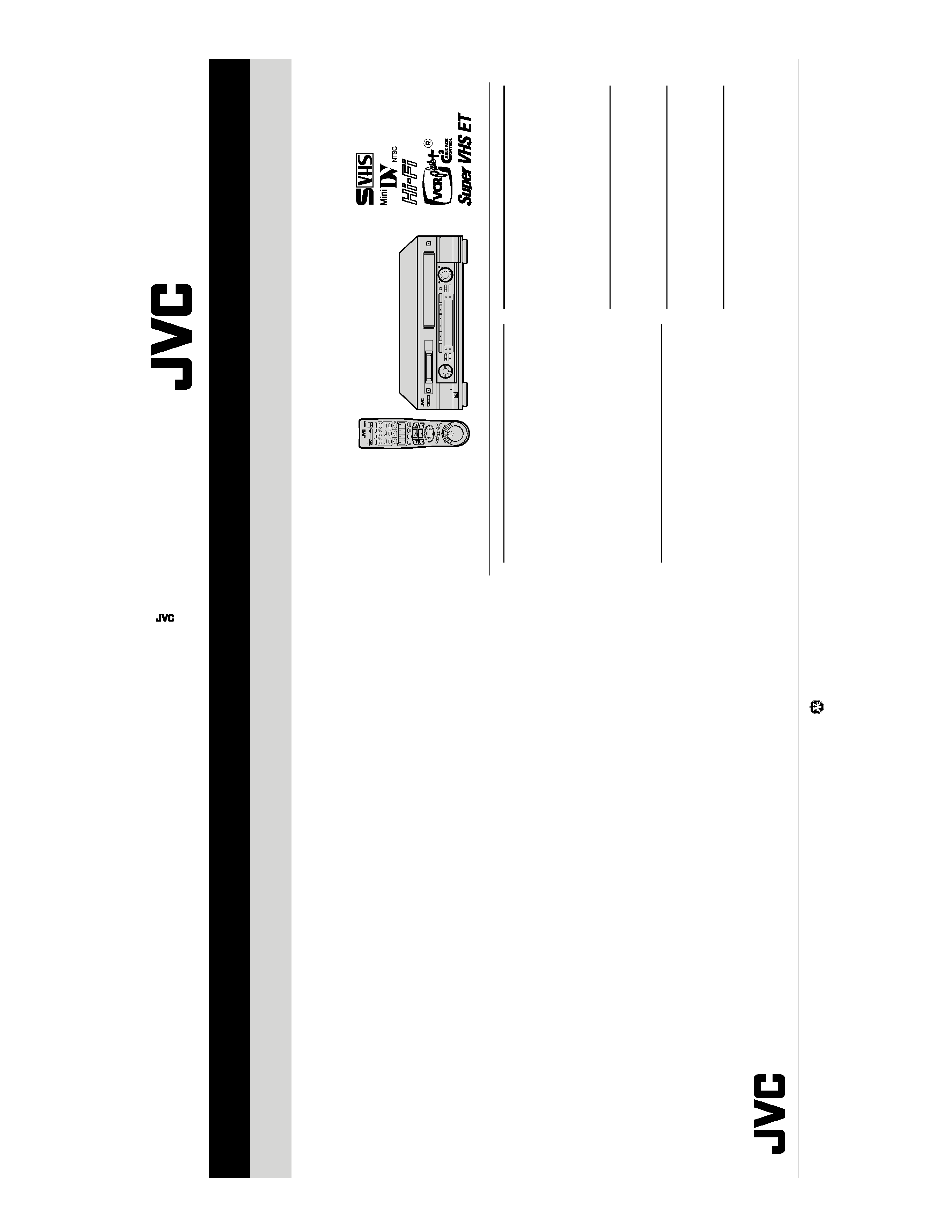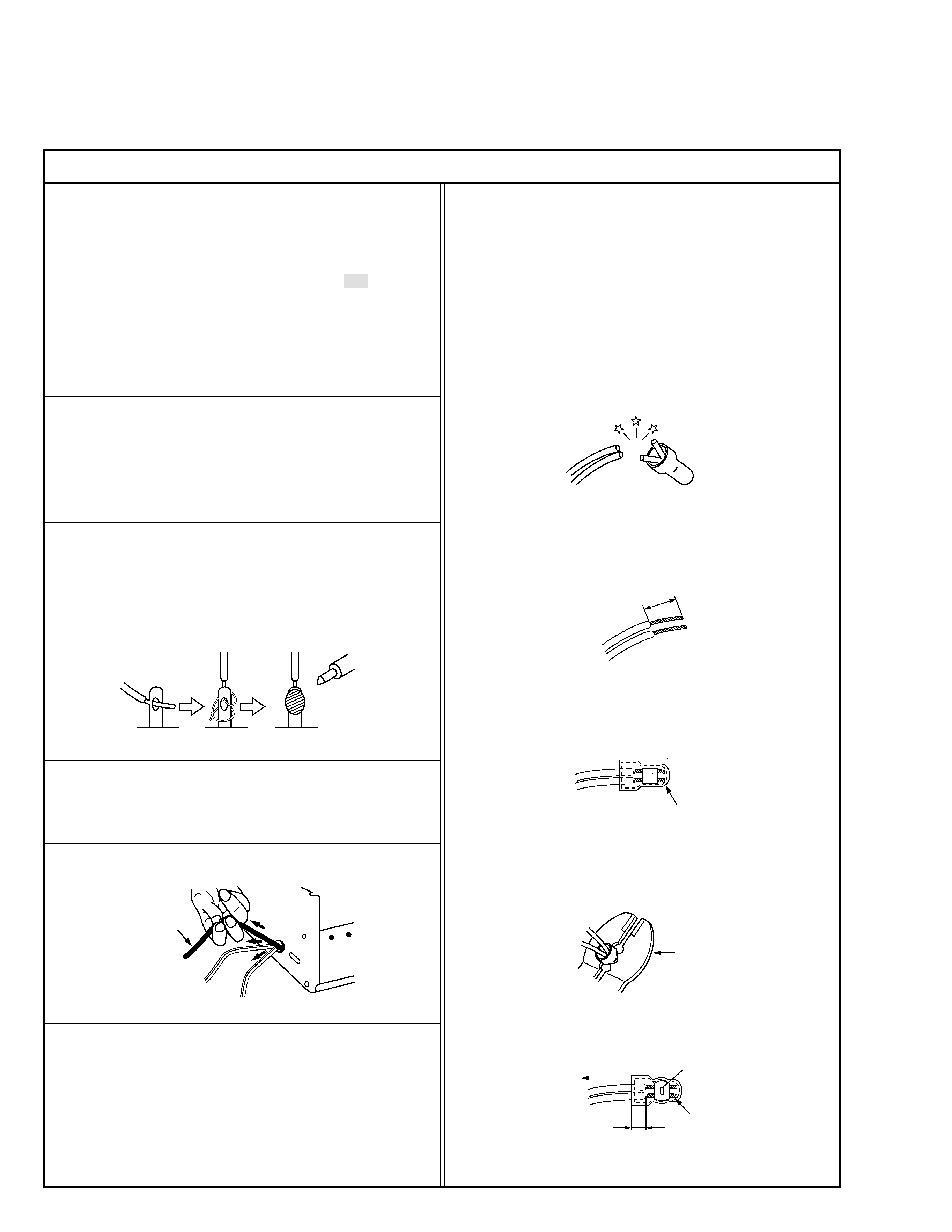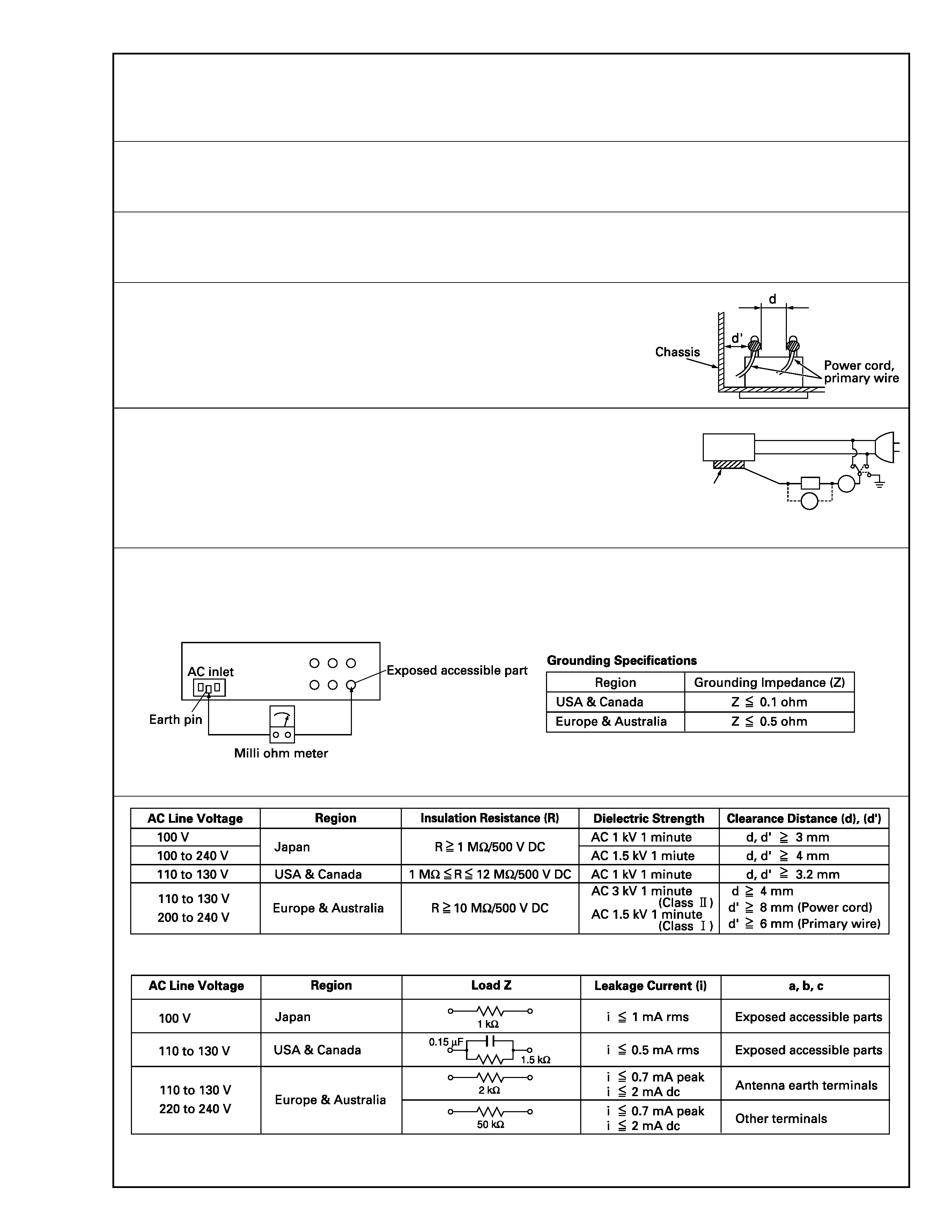
SERVICE MANUAL
No. 82855
March 2001
SR-VS20U
SPECIFICATIONS
Mini DV/S-VHS VIDEO CASSETTE RECORDER
Printed in Japan
This service manual is printed on 100% recycled paper.
COPYRIGHT © 2001 VICTOR COMPANY OF JAPAN, LTD.
SR-VS20U
No.
82855
JVC SERVICE & ENGINEERING COMPANY OF AMERICA
DIVISION OF JVC AMERICAS CORP.
Head office
East Coast
Midwest
West Coast
Atlanta
Hawaii
:
:
:
:
:
:
1700 Valley Road Wayne, New Jersey 07470-9976
10 New Maple Avenue Pine Brook, New Jersey 07058-9641
705 Enterprise Street Aurora, Illinois 60504-8149
5665 Corporate Avenue Cypress, California 90630-0024
1500 Lakes Parkway Lawrenceville, Georgia 30043-5857
2969 Mapunapuna Place Honolulu, Hawaii 96819-2040
(973)315-5000
(973)396-1000
(630)851-7855
(714)229-8011
(770)339-2582
(808)833-5828
JVC CANADA INC.
Head office
Montreal
Vancouver
:
:
:
21 Finchdene Square Scarborough, Ontario M1X 1A7
16800 Rte Trans-Canadienne, Kirkland, Quebec H9H 5G7
13040 Worster Court Richmond, B.C. V6V 2B3
(416)293-1311
(514)871-1311
(604)270-1311
S40895-03
123
45
6
7
89
0
2
4
1
3
T
W
DV
S-VHS
POWER
TV/VCR
A/B
DISPLAY
ENTER/OSD
A.MONITOR
VCR TV CABLE/DBS
CANCEL
TIMER
START
STOP
DATE
CH
C. RESET
DBS
DAILY(M-F)
AUX
WEEKLY
PROG
EXPRESS PROGRAMMING
PROG
CHECK
SP/LP
SP/EP
PLAY
REW
REC
STOP
PAUSE
FF
TV CH +
TV CH
TV
VOL
+
TV
VOL
MENU
OK
JOG/
SHUTTLE
T
I
D
E
.
A
.
R
T
U
O
/
N
I
T
R
A
T
S
DV IN/OUT
S-VHS
DV
A.DUB
INSERT
CH
DUB
DV
S-VHS
START
R.A.EDIT
IN/OUT
S-VHS ET
PULL - OPEN
REC
PAUSE
PLAY
STOP
EJECT
EJECT
POWER
GENERAL
Power requirement
: AC 120 V`, 60 Hz
Power consumption
Power on
: 35 W
Power off
: 5.5 W
Temperature
Operating
: 5°C to 40°C (41°F to 104°F)
Storage
: 20°C to 60°C (4°F to 140°F)
Operating position
: Horizontal only
Dimensions (WxHxD) : 435 mm x 127 mm x 390 mm
Weight
: 6.9 kg
Input/Output
: RCA connectors:
(IN x 2, OUT x 2)
S-Video connectors:
(IN x 2, OUT x 2)
DV connectors: (IN/OUT x 1)
(4-pin, IEEE1394 conformity, digital input/
output)
VHS DECK VIDEO/AUDIO
Signal system
: NTSC-type colour signal and EIA
monochrome signal, 525 lines/
60 fields
Recording system
: DA4 (Double Azimuth) head helical scan
system
Format
: S-VHS/VHS NTSC standard
Signal-to-noise ratio
: 45 dB
Horizontal resolution
: 240 lines (VHS)
400 lines (S-VHS)
Frequency range
: 70 Hz to 10,000 Hz
(Normal audio)
20 Hz to 20,000 Hz
(Hi-Fi audio)
Maximum recording time
(SP)
: 210 min. with ST-210 video cassette
(EP)
: 630 min. with ST-210 video cassette
DV DECK VIDEO/AUDIO
Signal system
: NTSC-type colour signal,
525 lines/60 fields
Recording system
: Digital Component Recording
Format
: DV format (SD mode)
Cassette
: Mini DV Cassette
Maximum recording time
(SP)
: 60 min. with M-DV60ME cassette
(LP)
: 90 min. with M-DV60ME cassette
Audio recording system
: PCM 48 kHz, 16 bit (2 ch)/
32 kHz, 12 bit (4 ch)
TUNER
Tuning system
: Frequency-synthesized tuner
Channel coverage
VHF
: Channels 213
UHF
: Channels 1469
CATV
: 113 Channels
TIMER
Clock reference
: Quartz
Program capacity
: 1-year programmable timer/
6 programs each on the VHS and DV
deck
Memory backup time
: Approx. 60 min.
ACCESSORIES
Provided accessories
: RF cable (F-type),
BNC/RCA adapter x 2, Infrared remote
control unit, "AA" battery x 2,
Audio/Video Cable,
S-Video cable (4-pin),
Controller
Specifications shown are for SP mode unless otherwise specified.
E. & O.E. Design and specifications subject to change without notice.

Important Safety Precautions
INSTRUCTIONS
1. DISASSEMBLY
1.1 HOW TO REMOVE THE MAJOR PARTS ..................................................... 1-1
1.1.1
Introduction .................................................................................... 1-1
1.2 HOW TO READ THE DISASSEMBLY AND ASSEMBLY .............................. 1-1
1.3 DISCONNECTION OF CONNECTORS (WIRES) ........................................ 1-1
1.4 SCREWS USED CABINET COMPONENTS AND BOARD ASSEMBLIES .. 1-1
1.5 HOW TO REMOVE THE MAJOR PARTS <COM section> ........................... 1-2
1.5.1
Disassembly flow chart .................................................................. 1-2
1.5.2
Disassembly/assembly method <COM section> ........................... 1-2
1.6 HOW TO REMOVE THE MAJOR PARTS <VHS section> ............................ 1-4
1.6.1
Disassembly flow chart .................................................................. 1-4
1.6.2
DIsassembly/assembly method <VHS section> ............................ 1-4
1.7 HOW TO REMOVE THE MAJOR PARTS <DV section> ............................... 1-6
1.7.1
Disassembly flow chart .................................................................. 1-6
1.7.2
Disassembly/assembly method <DV section> ............................... 1-6
1.8 SERVICE POSITIONS .................................................................................. 1-8
1.8.1
Service position <VHS SIDE> ....................................................... 1-8
1.8.2
Service position <DV SIDE> .......................................................... 1-9
1.9 MECHANISM SERVICE MODE .................................................................. 1-10
1.9.1
How to set the "MECHANISM SERVICE MODE" ........................ 1-10
1.10 CONNECTION .......................................................................................... 1-11
1.11 EMERGENCY DISPLAY FUNCTION ........................................................ 1-13
1.11.1
Displaying the emergency information ......................................... 1-13
1.11.2
Clearing the emergency history ................................................... 1-13
1.11.3
Emergency content description .................................................... 1-14
1.11.4
Emergency detail information 1 .................................................. 1-15
1.11.5
Emergency detail information 2 .................................................. 1-16
2. MECHANISM ADJUSTMENT (VHS)
2.1 Before Starting Repair and Adjustment ........................................................ 2-1
2.1.1
Precautions .................................................................................... 2-1
2.1.2
Checking for Proper Mechanical Operations ................................. 2-1
2.1.3
Manually Removing the Cassette Tape ......................................... 2-1
2.1.4
Jigs and Tools Required for Adjustment ........................................ 2-2
2.1.5
Maintenance and Inspection .......................................................... 2-3
2.2 Replacement of Major Parts .......................................................................... 2-6
2.2.1
Before Starting Disassembling (Phase matching between mechanical parts) . 2-6
2.2.2
How to Set the Mechanism Assembling Mode .............................. 2-6
2.2.3
Cassette Holder Assembly ............................................................ 2-6
2.2.4
Pinch Roller Arm Assembly ........................................................... 2-8
2.2.5
Guide Arm Assembly and Press Lever Assembly ......................... 2-8
2.2.6
Audio Control Head ....................................................................... 2-8
2.2.7
Loading Motor ................................................................................ 2-8
2.2.8
Capstan Motor ............................................................................... 2-9
2.2.9
Pole Base Assembly (supply or take-up side) ............................... 2-9
2.2.10 Rotary Encoder .......................................................................... 2-10
2.2.11 Clutch Unit ................................................................................. 2-10
2.2.12 Change Lever Assembly, Direct Gear, Clutch Gear and Coupling Gear 2-10
2.2.13 Link Lever ................................................................................... 2-11
2.2.14 Cassette Gear, Control Cam and Worm Gear ........................... 2-11
2.2.15 Control Plate .............................................................................. 2-11
2.2.16 Loading Arm Gear (supply or take-up side) and Loading Arm Gear Shaft 2-12
2.2.17 Take-up Lever, Take-up Head and Control Plate Guide ............. 2-13
2.2.18 Capstan Brake Assembly ........................................................... 2-13
2.2.19 Sub Brake Assembly (take-up side) ........................................... 2-13
2.2.20 Main Brake Assembly (take-up side), Reel Disk (take-up side) and
Main Brake Assembly (supply side) ................................................ 2-13
2.2.21 Tension Brake Assembly, Reel Disk (supply side) and Tension Arm Assembly 2-14
2.2.22 Idler Lever, Idler Arm Assembly ................................................. 2-14
2.2.23 Stator Assembly ......................................................................... 2-14
2.2.24 Rotor Assembly .......................................................................... 2-14
2.2.25 Upper Drum Assembly ............................................................... 2-15
2.3 Compatibility Adjustment ............................................................................. 2-16
2.3.1
Checking/Adjustment of FM Waveform Linearity ......................... 2-16
2.3.2
Checking/Adjustment of the Height and Tilt of the Audio Control Head 2-17
2.3.3
Checking/Adjustment of the Audio Control Head Phase (X-Value) .. 2-17
2.3.4
Checking/Adjustment of the Standard Tracking Preset ................ 2-18
2.3.5
Checking/Adjustment of the Tension Pole Position ...................... 2-18
MECHANISM ADJUSTMENT (DV)
2.9 PREPARATION ........................................................................................... 2-21
2.9.1
Precautions .................................................................................. 2-21
2.9.2
Tools Required for Adjustments ................................................... 2-21
2.9.3
Disassembly and Assembly Procedures ..................................... 2-21
2.9.4
Screws and Washers Used in Disassembly/Assembly of the
Mechanism Assembly .................................................................. 2-21
2.10 DISASSEMBLY/ASSEMBLY OF THE MECHANISM ASSEMBLY ............. 2-22
2.10.1 Introduction .................................................................................. 2-22
2.10.2 Mechanism Modes ...................................................................... 2-22
2.11 MECHANISM TIMING CHART ................................................................... 2-24
2.12 MECHANISM ASSEMBLY/DISASSEMBLY PROCEDURE TABLE ............ 2-25
2.13 DISASSEMBLY/ASSEMBLY ....................................................................... 2-27
2.14 LIST OF PROCEDURES FOR DISASSEMBLY ......................................... 2-35
2.15 MECHANISM DISASSEMBLY/ASSEMBLY SHEET ................................... 2-36
2.16 MECHANISM PHASE CHECK/ADJUSTMENT ......................................... 2-38
2.17 POSITIONING THE TENSION POLE ........................................................ 2-39
2.18 COMPATIBILITY AND ERROR RATE ADJUSTMENTS ............................ 2-40
2.18.1 Preparation ................................................................................ 2-40
2.18.2 Adjustment ................................................................................. 2-40
2.18.3 Linearity adjustment ................................................................... 2-41
2.18.4 PB switching point adjustment ................................................... 2-41
2.18.5 Error rate adjustment ................................................................. 2-41
2.18.6 Error rate measuring method ..................................................... 2-41
2.19 TAPE EJECTION ....................................................................................... 2-42
TABLE OF CONTENTS
Section
Title
Page
Section
Title
Page
3. ELECTRICAL ADJUSTMENT (VHS)
3.1 PRECAUTION ............................................................................................... 3-1
3.1.1 Required test equipments .............................................................. 3-1
3.1.2
Required adjustment tools ............................................................. 3-1
3.1.3 Color (colour) bar signal,Color (colour) bar pattern ....................... 3-1
3.1.4
Switch settings and standard precautions ..................................... 3-1
3.1.5
EVR Adjustment ............................................................................ 3-1
3.2 SERVO CIRCUIT .......................................................................................... 3-2
3.2.1
Switching point .............................................................................. 3-2
3.2.2
Slow tracking preset ...................................................................... 3-2
3.3 VIDEO CIRCUIT ........................................................................................... 3-2
3.3.1
D/A level ........................................................................................ 3-2
3.3.2
EE Y level ...................................................................................... 3-3
3.3.3
PB Y level (S-VHS / VHS) .............................................................. 3-3
3.3.4
REC color (colour) level ................................................................. 3-3
3.3.5
Video EQ (Frequency response) ................................................... 3-4
3.3.6
AUTO PICTURE initial setting ....................................................... 3-4
3.3.7
DV EE Y level ................................................................................. 3-4
3.4 AUDIO CIRCUIT ........................................................................................... 3-5
3.4.1
Audio REC FM ............................................................................... 3-5
3.5 DEMODULATOR CIRCUIT ........................................................................... 3-5
3.5.1
Input level ...................................................................................... 3-5
3.5.2
Stereo VCO ................................................................................... 3-5
3.5.3
Stereo filter .................................................................................... 3-6
3.5.4
Separation - 1 ................................................................................ 3-6
3.5.5
Separation - 2 ................................................................................ 3-6
3.5.6
SAP VCO ....................................................................................... 3-6
ELECTRICAL ADJUSTMENT (DV)
3.6 PREPARATION ............................................................................................. 3-7
3.6.1
Precautions .................................................................................... 3-7
3.6.2
Equipment required for adjustment ............................................... 3-7
3.6.3 Tools required for adjustments ....................................................... 3-7
3.6.4
Setup ............................................................................................. 3-7
4. CHARTS AND DIAGRAMS
NOTES OF SCHEMATIC DIAGRAM ................................................................... 4-1
CIRCUIT BOARD NOTES .................................................................................... 4-2
4.1 BOARD INTERCONNECTIONS ................................................................... 4-3
4.2 SWITCHING REGULATOR AND REGULATOR SCHEMATIC DIAGRAMS ........... 4-5
4.3 VIDEO/AUDIO SCHEMATIC DIAGRAM ....................................................... 4-7
4.4 SYSTEM CONTROL SCHEMATIC DIAGRAM ............................................. 4-9
4.5 SUB CPU SCHEMATIC DIAGRAM ............................................................. 4-13
4.6 TUNER SCHEMATIC DIAGRAM ................................................................ 4-15
4.7 VIDEO I/O SWITCH SCHEMATIC DIAGRAM ............................................ 4-17
4.8 AUDIO I/O SCHEMATIC DIAGRAM ............................................................ 4-19
4.9 CONNECTION SCHEMATIC DIAGRAM .................................................... 4-21
4.10 3D DIGITAL/4M SCHEMATIC DIAGRAM ................................................. 4-23
4.11 TERMINAL SCHEMATIC DIAGRAM ........................................................ 4-25
4.12 DEMODULATOR SCHEMATIC DIAGRAM ............................................... 4-27
4.13 S-SUB SCHEMATIC DIAGRAM ............................................................... 4-29
4.14 MDA SCHEMATIC DIAGRAM .................................................................. 4-31
4.15 PRE/REC SCHEMATIC DIAGRAM .......................................................... 4-33
4.16 ON SCREEN SCHEMATIC DIAGRAM ..................................................... 4-35
4.17 DISPLAY, EJECT SW, LED/SW, JACK AND JOG SCHEMATIC DIAGRAMS .......... 4-37
4.18 DV SYSTEM CONTROL SCHEMATIC DIAGRAM ................................... 4-39
4.19 DV MSD SCHEMATIC DIAGRAM ............................................................. 4-41
4.20 DV MAIN SCHEMATIC DIAGRAM ............................................................ 4-43
4.21 DV I/O SCHEMATIC DIAGRAM ................................................................ 4-45
4.22 DV V OUT SCHEMATIC DIAGRAM .......................................................... 4-47
4.23 AUDIO AD/DA SCHEMATIC DIAGRAM ................................................... 4-49
4.24 DV DSP SCHEMATIC DIAGRAM ............................................................. 4-51
4.25 SWITCHING REGULATOR AND REGULATOR CIRCUIT BOARDS .......... 4-53
4.26 3D DIGITAL/4M AND S-SUB CIRCUIT BOARDS .................................... 4-55
4.27 TERMINAL CIRCUIT BOARD .................................................................. 4-56
4.28 S-SUB AND DISPLAY, EJECT SW, JACK, LED/SW, JOG CIRCUIT BOARDS . 4-57
4.29 MAIN CIRCUIT BOARD ........................................................................... 4-59
4.30 DEMODULATOR AND ON SCREEN CIRCUIT BOARDS ........................ 4-62
4.31 P/R MDA, DV MAIN CIRCUIT BOARDS .................................................. 4-63
4.32 FDP GRID ASSIGNMENT AND ANODE CONNECTION ........................ 4-69
4.33 REMOTE CONTROL SCHEMATIC DIAGRAM ........................................ 4-70
4.34 WAVEFORMS ........................................................................................... 4-71
4.35 VOLTAGE CHARTS .................................................................................. 4-73
4.36 CPU PIN FUNCTION ................................................................................ 4-76
4.37 SYSTEM CONTROL BLOCK DIAGRAM (VHS) ....................................... 4-77
4.38 VIDEO BLOCK DIAGRAM(VHS) .............................................................. 4-79
4.39 AUDIO BLOCK DIAGRAM (VHS) ............................................................. 4-83
4.40 SYSTEM CONTROL BLOCK DIAGRAM (DV) ......................................... 4-85
4.41 VIDEO BLOCK DIAGRAM (DV) ................................................................ 4-87
5. PARTS LIST
5.1 PACKING AND ACCESSORY ASSEMBLY <M1> ....................................... 5-1
5.2 FINAL ASSEMBLY <M2> ............................................................................. 5-2
5.3 MECHANISM ASSEMBLY (VHS) <M3> ...................................................... 5-4
5.4 MECHANISM ASSEMBLY (DV) <M4> ......................................................... 5-6
5.5 ELECTRICAL PARTS LIST ........................................................................... 5-8
SW REGULATOR BOARD ASSEMBLY <01> ........................................... 5-8
REGULATOR BOARD ASSEMBLY <02> ................................................. 5-9
MAIN BOARD ASSEMBLY <03> ............................................................ 5-10
3D DIGITAL/4M BOARD ASSEMBLY <05> ............................................ 5-18
TERMINAL BOARD ASSEMBLY <06> ................................................... 5-19
A/C HEAD BOARD ASSEMBLY <12> .................................................... 5-20
DEMOD BOARD ASSEMBLY <14> ........................................................ 5-20
S-SUB BOARD ASSEMBLY <15> .......................................................... 5-21
DV PRE/REC MDA BOARD ASSEMBLY <16> ....................................... 5-22
ON SCREEN BOARD ASSEMBLY <17> ................................................ 5-23
EJECT SW BOARD ASSEMBLY <27> ................................................... 5-24
SW/DISPLAY BOARD ASSEMBLY <28> ................................................ 5-24
JACK BOARD ASSEMBLY <36> ............................................................ 5-25
LED/SW BOARD ASSEMBLY <47> ....................................................... 5-25
DV MAIN BOARD ASSEMBLY <50> ....................................................... 5-25
LOADING MOTOR BOARD ASSEMBLY <55> ....................................... 5-31
JOG BOARD ASSEMBLY <85> .............................................................. 5-31

Important Safety Precautions
Prior to shipment from the factory, JVC products are strictly inspected to conform with the recognized product safety and electrical codes of the
countries in which they are to be sold. However, in order to maintain such compliance, it is equally important to implement the following precautions
when a set is being serviced.
Fig.1
1. Locations requiring special caution are denoted by labels and in-
scriptions on the cabinet, chassis and certain parts of the product.
When performing service, be sure to read and comply with these
and other cautionary notices appearing in the operation and serv-
ice manuals.
2. Parts identified by the
! symbol and shaded (
) parts are
critical for safety.
Replace only with specified part numbers.
Note: Parts in this category also include those specified to com-
ply with X-ray emission standards for products using
cathode ray tubes and those specified for compliance
with various regulations regarding spurious radiation
emission.
3. Fuse replacement caution notice.
Caution for continued protection against fire hazard.
Replace only with same type and rated fuse(s) as specified.
4. Use specified internal wiring. Note especially:
1) Wires covered with PVC tubing
2) Double insulated wires
3) High voltage leads
5. Use specified insulating materials for hazardous live parts. Note
especially:
1) Insulation Tape
3) Spacers
5) Barrier
2) PVC tubing
4) Insulation sheets for transistors
6. When replacing AC primary side components (transformers, power
cords, noise blocking capacitors, etc.) wrap ends of wires securely
about the terminals before soldering.
Power cord
Fig.2
10. Also check areas surrounding repaired locations.
11. Products using cathode ray tubes (CRTs)
In regard to such products, the cathode ray tubes themselves, the
high voltage circuits, and related circuits are specified for compli-
ance with recognized codes pertaining to X-ray emission.
Consequently, when servicing these products, replace the cath-
ode ray tubes and other parts with only the specified parts. Under
no circumstances attempt to modify these circuits.
Unauthorized modification can increase the high voltage value and
cause X-ray emission from the cathode ray tube.
12. Crimp type wire connector
In such cases as when replacing the power transformer in sets
where the connections between the power cord and power trans-
former primary lead wires are performed using crimp type connec-
tors, if replacing the connectors is unavoidable, in order to prevent
safety hazards, perform carefully and precisely according to the
following steps.
1) Connector part number : E03830-001
2) Required tool : Connector crimping tool of the proper type which
will not damage insulated parts.
3) Replacement procedure
(1) Remove the old connector by cutting the wires at a point
close to the connector.
Important : Do not reuse a connector (discard it).
Fig.7
cut close to connector
Fig.3
(2) Strip about 15 mm of the insulation from the ends of the
wires. If the wires are stranded, twist the strands to avoid
frayed conductors.
15 mm
Fig.4
(3) Align the lengths of the wires to be connected. Insert the
wires fully into the connector.
Connector
Metal sleeve
Fig.5
(4) As shown in Fig.6, use the crimping tool to crimp the metal
sleeve at the center position. Be sure to crimp fully to the
complete closure of the tool.
I
·Precautions during Servicing
7. Observe that wires do not contact heat producing parts (heatsinks,
oxide metal film resistors, fusible resistors, etc.)
8. Check that replaced wires do not contact sharp edged or pointed
parts.
9. When a power cord has been replaced, check that 10-15 kg of
force in any direction will not loosen it.
1.2
5
2.0
5.5
Crimping tool
Fig.6
(5) Check the four points noted in Fig.7.
Not easily pulled free
Crimped at approx. center
of metal sleeve
Conductors extended
Wire insulation recessed
more than 4 mm
S40888-01

·Safety Check after Servicing
Examine the area surrounding the repaired location for damage or deterioration. Observe that screws, parts and wires have been returned
to original positions, Afterwards, perform the following tests and confirm the specified values in order to verify compliance with safety
standards.
1. Insulation resistance test
Confirm the specified insulation resistance or greater between power cord plug prongs and exter-
nally exposed parts of the set (RF terminals, antenna terminals, video and audio input and output
terminals, microphone jacks, earphone jacks, etc.). See table 1 below.
2. Dielectric strength test
Confirm specified dielectric strength or greater between power cord plug prongs and exposed acces-
sible parts of the set (RF terminals, antenna terminals, video and audio input and output terminals,
microphone jacks, earphone jacks, etc.). See table 1 below.
3. Clearance distance
When replacing primary circuit components, confirm specified clearance distance (d), (d') be-
tween soldered terminals, and between terminals and surrounding metallic parts. See table 1
below.
4. Leakage current test
Confirm specified or lower leakage current between earth ground/power cord plug prongs and
externally exposed accessible parts (RF terminals, antenna terminals, video and audio input and
output terminals, microphone jacks, earphone jacks, etc.).
Measuring Method : (Power ON)
Insert load Z between earth ground/power cord plug prongs and externally exposed accessible
parts. Use an AC voltmeter to measure across both terminals of load Z. See figure 9 and following
table 2.
5. Grounding (Class 1 model only)
Confirm specified or lower grounding impedance between earth pin in AC inlet and externally exposed accessible parts (Video in, Video out,
Audio in, Audio out or Fixing screw etc.).
Measuring Method:
Connect milli ohm meter between earth pin in AC inlet and exposed accessible parts. See figure 10 and grounding specifications.
Fig. 10
Fig. 9
Fig. 8
Table 1 Specifications for each region
Table 2 Leakage current specifications for each region
Note: These tables are unofficial and for reference only. Be sure to confirm the precise values for your particular country and locality.
II
S40888-01
ab
c
V
A
Externally
exposed
accessible part
Z

